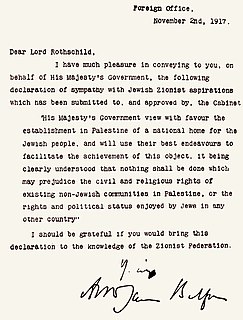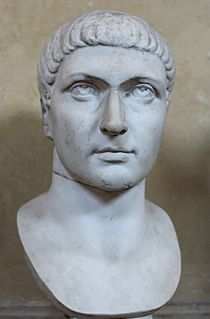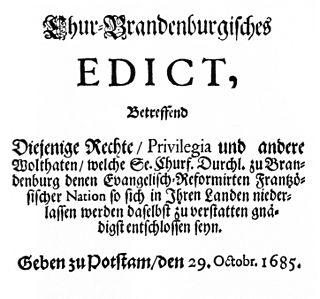 W
WThe 1782 Edict of Tolerance was a religious reform of Emperor Joseph II during the time he was emperor of the Habsburg Monarchy as part of his policy of Josephinism, a series of drastic reforms to remodel Austria in the form of the ideal Enlightened state. Joseph II's enlightened despotism included the Patent of Toleration, enacted in 1781, and the Edict of Tolerance in 1782. The Patent of Toleration granted religious freedom to the Lutherans, Calvinists, and Serbian Orthodox, but it was not until the 1782 Edict of Tolerance that Joseph II extended religious freedom to the Jewish population.
 W
WThe Balfour Declaration was a public statement issued by the British government in 1917 during the First World War announcing support for the establishment of a "national home for the Jewish people" in Palestine, then an Ottoman region with a small minority Jewish population. The declaration was contained in a letter dated 2 November 1917 from the United Kingdom's Foreign Secretary Arthur Balfour to Lord Rothschild, a leader of the British Jewish community, for transmission to the Zionist Federation of Great Britain and Ireland. The text of the declaration was published in the press on 9 November 1917.
 W
WThe Cambon letter was an unpublished letter to Zionist diplomat Nahum Sokolow issued by the French government in 1917 during the First World War announcing support for the Zionist project in Palestine, then an Ottoman region with a small minority Jewish population. It read: You were good enough to present the project to which you are devoting your efforts, which has for its object the development of Jewish colonization in Palestine.You consider that, circumstances permitting, and the independence of the Holy Places being safeguarded on the other hand, it would be a deed of justice and of reparation to assist, by the protection of the Allied Powers, in the renaissance of the Jewish nationality in that Land from which the people of Israel were exiled so many centuries ago. The French Government, which entered this present war to defend a people wrongfully attacked, and which continues the struggle to assure the victory of right over might, can but feel sympathy for your cause, the triumph of which is bound up with that of the Allies. I am happy to give you herewith such assurance.
 W
WThe Edict of Châteaubriant, issued from the seat of Anne, duc de Montmorency in Brittany, was promulgated by Henri II of France, 27 June 1551. The Edict was one of an increasingly severe series of measures taken by Henry II against Protestants, whom he regarded as heretics. In the preamble, the Edict frankly reported that previous measures against heresy in the kingdom had proved ineffectual. "Heretics", the Edict reported, met in conventicles, infected schools, invaded the judicial bench and forced toleration upon judges. To ensure more rigorous judgements, in 1547 Henri had already created a special judicial chamber drawn from members of the parlements, solely to judge cases of heresy (called by Protestants the Chambre Ardente. The Edict contained quite detailed provisions: it called upon the civil and ecclesiastical courts to detect and punish all heretics, and placed severe restrictions on Protestants, including loss of one-third of property granted to informers, who were also granted immunity and confiscations of property both moveable and immovable belonging to those who had fled to Geneva, with whom the king's subjects were forbidden to correspond or to send money. Fourteen of its forty-six articles were concerned with censorship; its terms strictly regulated the press by prohibiting the sale, importation or printing of any book unapproved by the Faculty of Theology at the University of Paris, then or, now it was implied, in the future. Booksellers were to display a copy of the Faculty's printed list of prohibited books alongside a list of books for sale. Delegates of the Faculty were to make visits twice a year to each bookseller to ensure that the provisions were complied with. Since 1542 it had been a requirement that any shipment of books into France be opened and unpacked in the presence of delegates from the Faculty of Theology, which now, according to Roger Doucet, "assumed the intellectual direction of the kingdom."
 W
WThe Edict of Compiègne, issued from his Château de Compiègne by Henry II of France, 24 July 1557, applied the death penalty for all convictions of relapsed and obstinate "sacramentarians", for those who went to Geneva or published books there, for iconoclast blasphemers against images, and even for illegal preaching or participation in religious gatherings, whether public or private. It was the third in a series of increasingly severe punishments for expressions of Protestantism in France, which had for an aim the extirpation of the Reformation. By raising the stakes, which now literally became matters of life and death, the Edict had the result of precipitating the long religious crisis in France and hastening the onset of armed civil war between armies mustered on the basis of religion, the series of French Wars of Religion, which were not settled until Henri IV's edict of toleration, the Edict of Nantes (1598).
 W
WThe Constitutio Antoniniana was an edict issued on 11 July in AD 212, by the Roman Emperor Caracalla. It declared that all free men in the Roman Empire were to be given full Roman citizenship and that all free women in the Empire were to be given the same rights as Roman women, with the exception of the dediticii, people who had become subject to Rome through surrender in war, and freed slaves.
 W
WThe Gülhane Hatt-ı Şerif or Tanzimât Fermânı was a proclamation by Ottoman Sultan Abdülmecid I in 1839 that launched the Tanzimât period of reforms and reorganization in the Ottoman Empire. The 125th anniversary of the edict was depicted on a former Turkish postcard stamp.
 W
WHatt-i humayun, also known as hatt-i sharif, is the diplomatics term for a document or handwritten note of an official nature composed by an Ottoman Sultan. The terms come from hatt, hümayun (imperial) and şerif. These notes were commonly written by the Sultan personally, although they could also be transcribed by a palace scribe. They were written usually in response to, and directly on, a document submitted to the sultan by the grand vizier or another officer of the Ottoman government. Thus, they could be approvals or denials of a letter of petition, acknowledgements of a report, grants of permission for a request, an annotation to a decree, or other government documents. Hatt-ı hümayuns could be composed from scratch, rather than as a response to an existing document. After the Tanzimat reform (1856), aimed to modernize the Ottoman Empire, hatt-ı hümayuns of the routine kind were supplanted by the practice of irâde-i seniyye, in which the Sultan's spoken response was recorded on the document by his scribe.
 W
WThe Exile of Mawzaʻ Hebrew: גלות מוזע, pronounced [ğalūt mawzaʻ]; 1679–1680, is considered the single most traumatic event experienced collectively by the Jews of Yemen, in which Jews living in nearly all cities and towns throughout Yemen were banished by decree of the king, Imām al-Mahdi Ahmad, and sent to a dry and barren region of the country named Mawzaʻ to withstand their fate or to die. Only a few communities, viz., those Jewish inhabitants who lived in the far eastern quarters of Yemen were spared this fate by virtue of their Arab patrons who refused to obey the king's orders. Many would die along the route and while confined to the hot and arid conditions of this forbidding terrain. After one year in exile, the exiles were called back to perform their usual tasks and labors for the indigenous Arab populations, who had been deprived of goods and services on account of their exile.
 W
WThe Edict on Maximum Prices was issued in 301 AD by Roman Emperor Diocletian.
 W
WThe Edict of Milan was the February AD 313 agreement to treat Christians benevolently within the Roman Empire. Western Roman Emperor Constantine I and Emperor Licinius, who controlled the Balkans, met in Mediolanum and, among other things, agreed to change policies towards Christians following the edict of toleration issued by Emperor Galerius two years earlier in Serdica. The Edict of Milan gave Christianity legal status and a reprieve from persecution but did not make it the state church of the Roman Empire. That occurred in AD 380 with the Edict of Thessalonica.
 W
WThe Imperial Reform Edict was a February 18, 1856 edict of the Ottoman government and part of the Tanzimat reforms. The decree from Ottoman Sultan Abdulmejid I promised equality in education, government appointments, and administration of justice to all regardless of creed. The decree is often seen as a result of the influence of France and Britain, which assisted the Ottoman Empire against the Russians during the Crimean War (1853–1856) and the Treaty of Paris (1856) which ended the war.
 W
WThe Edict of Paris was promulgated 18 October 614 in Paris by Chlothar II, the Merovingian king of the Franks. It is one of the most important royal instruments of the Merovingian period in Frankish history and a hallmark in the history of the development of the Frankish monarchy. It is the last of the Merovingian capitularia, a series of legal ordinances governing church and realm.
 W
WThe Edict of Pîtres was a capitulary promulgated at Pîtres on 25 June 864. It is often cited by historians as an example of successful government action on the part of Charles the Bald, King of West Francia.
 W
WThe Edict of Potsdam was a proclamation issued by Frederick William, Elector of Brandenburg and Duke of Prussia, in Potsdam on October 29, 1685, as a response to the revocation of the Edict of Nantes by the Edict of Fontainebleau. It encouraged Protestants to relocate to Brandenburg.
 W
WThe Praetor's Edict (Edictum praetoris) in ancient Roman law was an annual declaration of principles made by the new praetor urbanus – the elected magistrate charged with administering justice within the city of Rome. During the early Empire the Praetor's Edict was revised to become the Edictum perpetuum.
 W
WThe Edict of Restitution, which passed eleven years into the Thirty Years' War on March 6, 1629, in the city of Vienna, following Catholic successes at arms, was a belated attempt by Ferdinand II, Holy Roman Emperor to restore the religious and territorial situations reached in the Peace of Augsburg (1555), whose "Ecclesiastical Reservation" had impeded the secularization of Catholic church lands after 1555, as no further Catholic church lands could legally be transferred to Protestant control. However, for several decades weak emperors had been unable to enforce the "Ecclesiastical Reservation" against Protestant encroachments.
 W
WThe Edictum Rothari was the first written compilation of Lombard law, codified and promulgated on 22 November 643 by King Rothari. According to Paul the Deacon, the 8th century Lombard historian, the custom law of the Lombards had been held in memory before this. The Edict, recorded in Vulgar Latin, comprised primarily the Germanic custom law of the Lombards, with some modifications to limit the power of feudal rulers and strengthen the authority of the king. Although the edict has been drafted in Latin, few lombard words were untranslatable, as "grabworfin, arga, sculdhais, morgingab, metfio, federfio, mahrworfin, launegild, thinx, waregang, gastald, mundius, angargathung, fara, walupaus, gairethinx, aldius, actugild or, wegworin".
 W
WThe Edict of Serdica, also called Edict of Toleration by Galerius, was issued in 311 in Serdica by Roman Emperor Galerius. It officially ended the Diocletianic Persecution of Christianity in the Eastern Roman Empire.